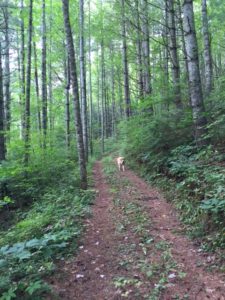![eastern-hemlock-tree-trunk[1]](http://jeanraffa.files.wordpress.com/2012/02/eastern-hemlock-tree-trunk1.jpg?w=225) Every archetype has a dual nature because the ego automatically sees everything from a dualistic perspective. We divide the spiritual realm into the powerful opposing forces of God (good) and Devil (evil) and label everything else the same way. Last February I wrote that the Tree of Knowledge represents our potential for a great awakening into an enlightened wisdom yet is also associated with humanity’s disobedience and fall from eternal intimacy with God. Similarly, there are myths depicting the Scandinavian ash and shamanism’s birch as Trees of Life, yet Christianity’s savior Jesus loses his life on a tree.
Every archetype has a dual nature because the ego automatically sees everything from a dualistic perspective. We divide the spiritual realm into the powerful opposing forces of God (good) and Devil (evil) and label everything else the same way. Last February I wrote that the Tree of Knowledge represents our potential for a great awakening into an enlightened wisdom yet is also associated with humanity’s disobedience and fall from eternal intimacy with God. Similarly, there are myths depicting the Scandinavian ash and shamanism’s birch as Trees of Life, yet Christianity’s savior Jesus loses his life on a tree.
In a post last August I wrote that the Disney Princesses are uniformly young, slender, beautiful, sweetly shy, innocently seductive, charmingly vulnerable, and, for the most part, deferential to males. If we take these stories as literal models for gender behavior, few would disagree that they reinforce very limiting and potentially damaging stereotypes. But a different perspective emerges if we view them as representations of the Maiden phase of the anima archetype. Then they are forces for good, not evil, and the only problem they present is our insistence that the anima, and by association human women, must remain in this phase forever.
 Did anyone sign your high school yearbook, “Don’t ever change”? Maybe you wrote it yourself. This is the normal desire of an adolescent ego. What it wants is so simple: to be old enough to drive, get a job, earn a lot of money, become independent, satisfy all its instinctual desires as much as it wants to…and then stay that way forever.
Did anyone sign your high school yearbook, “Don’t ever change”? Maybe you wrote it yourself. This is the normal desire of an adolescent ego. What it wants is so simple: to be old enough to drive, get a job, earn a lot of money, become independent, satisfy all its instinctual desires as much as it wants to…and then stay that way forever.
We don’t want to face the reality that we are changing with the seasons and will someday die like my favorite tree, a large hemlock on our North Carolina property that began its life about 400 years ago and grew to 90 feet tall. Half her trunk at the point where it divided into two main branches crashed to the ground last weekend. We want to believe we’re smarter than that tree, that if we can keep the same looks, body size, beliefs, personality and life-style we had as late adolescents, we can somehow ward off aging and dying.
My hemlock’s trunk reminded me of a mature woman in a flowing gown. I thought of her needles as hair. She began her life when a cone released a seed one winter long ago. The seed grew into a pretty, pliable Maiden sapling who swayed and danced with the breezes. At age 15 she produced cones and became a Mother. Some hemlocks produce excellent crops of cones for more than 450 years before retiring to enjoy their remaining years as grandmother Crones who continue to bless the birds with safe haven for nests and the land beneath with cool shade.
 Did you ever notice that by adolescence the Disney Princesses no longer have loving mothers or grandmothers to protect them? The only older women who come to mind are evil step-mothers, a ditzy fairy god-mother, and a singing teapot! Why this scarcity of images of healthy, mature women in fantasy land? Might this curious fact be related to Viv’s observation after my last post that, “Anorexia seems to fossilize girls at a pre-pubescent stage, before they become women.”?
Did you ever notice that by adolescence the Disney Princesses no longer have loving mothers or grandmothers to protect them? The only older women who come to mind are evil step-mothers, a ditzy fairy god-mother, and a singing teapot! Why this scarcity of images of healthy, mature women in fantasy land? Might this curious fact be related to Viv’s observation after my last post that, “Anorexia seems to fossilize girls at a pre-pubescent stage, before they become women.”?
The Maiden phase of the anima represents everything about the feminine that is sweet, beautiful, innocent and hopeful. But the flip side of the Disney Princesses is that they perpetuate our unconscious aversion to the natural cycles of life and the mature stages of feminine development. After all, an adolescent ego can control little girls far easier than Nature and wise men, women and crones!

A Lesson on Aging
I’m so happy to be back in the mountains. I love the weather, the trees, the birds, the rushing creek, the flowering bushes. The beauty.





0 Responses
Excellent post.
It’s so true that we do not seem to like the other aspects of being woman, in terms of society.
Time Disney made a film where Granny is a heroine. Terry Pratchett’s work has brought the crone aspect into great prominence.
Thank you, Viv. And thanks for the heads up about the Disney Granny film. It’s about time!!! I haven’t seen it but would love to. Do you remember the title? I’ve seen you mention Terry Pratchett’s work several times and have ordered Hogfather for my kindle. I guess it’s time I read it! I appreciate your always timely comments. Jeanie
Oops, sorry to mislead you. I meant it’s about time Disney made a film where granny is the main character.
if you can get a hold of any of Pratchett’s Witches books ( Witches Abroad is a version of Cinderella) the central characters of these are the wonderful Granny Weatherwax, her best friend Nanny Ogg and Magrat Garlick (the youngest witch who represents the maiden in the trio). I wish someone would get round to making them into films. Granny is quite simply the most fabulous old battleaxe. I find the writing crisp and the dialogue hysterically funny at times but there is depth that is astonishing for someone who claims to be agnostic if not atheist!
Oh! I thought there was a special new branch of Disney called “Time Disney!” that was venturing outside the box to keep up with the times! I’ll definitely check out Pratchett’s Witches books! They sound wonderful! I wonder if they were the model for the film “Witches of Eastwick” which was made into a delightful film some time back…. J
Jeanie,
The brick patio in our very small back yard winds around a birch tree, we planted as a sapling over fifteen years ago. It now towers above the roof of our house. My upstairs office windows overlook this patio and as I sit reading your post, I gaze out at the serrated, curly, irregular, thin-skinned bark covering the trunk and bare branches of our birch. I never tire of meditating on the amazing beauty of the wrinkles, peels and pocks of its aging skin, attributes culturally abhorred in its human counterpart.
I agree with you that we humans have strangely skewed values–we honor the unsurpassable beauty of aging in nature, yet are repelled when human skin follows its natural course.
Thanks again for your musings and insights.
Lovingly,
Sally
Hi Sally,
It’s very good to hear from you! So you have a shaman’s birch in your back yard! Very cool. Yes, I love tree bark too. One of the most beautiful sights I’ve ever beheld is a fantastic massive boulder beside a North Carolina waterfall that stopped me in my tracks. It has the most gorgeous pattern of deeply etched wrinkles I’ve ever seen. After gazing at it for a while I couldn’t help but say to my companions “Tell me wrinkles aren’t beautiful!” I do wish we could get past the age thing to appreciate the beauty of older women…. The negativity and judgment directed toward them is so sad and painful to so many.
Much love,
Jeanie
Jeanie,
Tell me about the shaman birch. This was a tree I had to have and when we moved into the house where we live now, it was one of the first things I planted, but I know nothing of its mythical or mystical connections.
Actually, I don’t either, Sally. I came across it in one of my reference books when I wrote that original post about trees, but after searching for my source for the last half hour I can’t find it! But I’ll share a few associations with trees that might have been meaningful for shamans: Chetwynd says “In the scale of evolution the tree is intermediary between inanimate matter (the earth) and the conscious mind,” and also “it is a very ancient symbol of upward ascent, step by step, stage by stage, whether for the race of mankind or for the individual.” In that regard it is somewhat like Jacob’s ladder to heaven: a symbol that one is acquiring a higher consciousness. Shamans are ones who take these kinds of spiritual journeys, both to the underworld (roots) and heavens (branches) so I would suspect this is a primary association for them. Another association is union: i.e., between heaven and earth, and for Jung, between masculinity and femininity (masculine, phallic trunk/feminine fruitfulness and protectiveness for birds, nests, and eggs.)
Some trees do have specific meanings based on their color, size, shape, fruit, and so on. As for the birch, all I can find is that it is a symbol, particularly in Russia, of spring and of the young girl! Hey! I like it that I mentioned the birch in this article. A lovely synchronicity: Leave it to those shamans to understand the beauty and value of the Maiden! So perhaps your birch reminds you of the pleasures and beauty of your youth? Also, it occurs to me that if we’re talking about white birches, they have this marvelous grayish collection of shadings between black and white, which also suggests the union of opposites and, for me the Crone!
That’s about the best I can do for now, but if I come across my original source and find out more, I’ll let you know.
Love, Jeanie
Beautiful and thought provoking, Jeanie. I for one find the beauty of a healthy and mature woman most alluring. Wisdom is a large part of beauty, which, in my opinion, cannot be attained through body sculpting, six-pack abs and a tan. Sadly, however, young men and women are still being besieged with these idiotic, misguided notions of beauty. It’s distressing. Tell us what you really think, Charlie, you’re probably saying about now, right Jeanie? But seriously, it seems to me that people waste an enormous amount of energy on these false ideals.
Anyway, you wrote, “Why this scarcity of images of healthy, mature women in fantasy land?” I’d love to hear your thoughts on this.
Charlie
I find it distressing too, Charlie. “Why this scarcity of images of healthy, mature women in fantasy land?” I think there are many reasons, all of which can be traced to the current status of the collective ego which appears to be in an adolescent stage of growth. I mean this from an evolutionary perspective. The sages and spirit persons of the world have shown us throughout history that it is possible to evolve past this stage of outer-referential, dualistic, youth-oriented thinking to a maturely integrated, inner-referential and holistic way of perceiving life, but the bulk of humanity is just not there yet. So I see the mindset I’ve described in this post as the product of our immaturity as a species which is trying its best to grow up but whose cultural products and standards are still governed by an adolescent mentality which, in turn, creates the same mentality in its children.
Some of us are like a rebellious adolescent who would rather hang out with his/her peers and party with no concern for tomorrow than stay home and study for a long term goal it doesn’t really understand and can barely even imagine. From this perspective, grown-ups (especially mothers) are of no further value to us. They’re just fuddy-duddies trying to spoil our fun.
Others respect the important adults and authorities in our world and do our best to please them by being as responsible as we can and studying and working hard to attain their goals and make them proud of us, but in doing so we often ignore our own true feelings or interests. Then we wake up one day wondering why we’re not enjoying our lives and if this is all there is without having a clue what to do next. In this scenario we’ve bought into cultural values and standards fashioned by a collective adolescent ego which emphasizes the youthful striving phase of life and would rather not look very hard at what happens after that because it still doesn’t want to face its own aging, let alone its mortality. As long as the dominant messages we receive as children come from an adolescent youth-oriented mentality, we have no preparation or support from society about how to keep growing and expand our awareness to include respect for the latter phases of life.
Either way it’s up to us to wake ourselves up with intentional practices aimed at self-understanding and self-development so we can learn to value and be of benefit to ourselves and others at every stage of life.
So that’s the short answer! Thanks for asking!
Jeanie, Thank you for your evocative and most thoughtful response to my query on trees, birch trees in particular. I so appreciate your time and the assimilation of your research to keep us always reaching in our understanding.
Sally
You’re welcome, Sally. My pleasure!
I was a rebellious adolescent and didn’t realize at the time that my actions, unfathomable to me, stemmed from anger. The anger was justified. Much later, after leading a conscientious adult life: working, raising children, staying on the straight and narrow path, I now find myself looking for ways to honor my inner adolescent. Given the time and place, I think she was pretty brave.
I think she was very brave: far braver than mine at that age! Our stories are parallel except they come from opposite directions! I was the most dutiful, accommodating adolescent that ever existed: a Disney Princess who assumed I should stay that way my whole life because I knew that was what my family and society wanted of me. My repressed rebellious adolescent only emerged when I was 37, and, like you, it was due to anger. Only by honoring her was I able to grow beyond either extreme and find a comfortable place in the middle space between them!! Thank you for your helpful comment!
Hi Jeanie, a belated comment here, I had read the post when posted and don’t know if this was related but…. Normally for me dreams have been humdrum daily reports, getting shopping, cleaning the house, going to work etc but a few days back I had an experience of dreaming of this huge lush strong vibrant tree whose trunk reached up to the heavens , there were a few of us listening to a commentator who was describing how bees and other insects would attach themselves to the tree and from the sap coming into them would change into flowers. It next felt that I had become the tree and as I began to waken up I could feel the bees legs sinking into my eyes… I tried to brush it away but it successfully turned into a flower… I awakened both exhilarated and frightened. I’m blaming you for all this :-).
Oh, dear! Terribly sorry about that! 🙂
Seriously, it sounds like an amazing dream! So if I read it right, the sap of this Tree of Life changes bees and insects into flowers, then you become the tree and then it is you who are then transforming bees and insects into flowers.
If this were my dream I would wonder if my particularly beautiful poem about this dream, (which I, Jeanie, have read on your blog and enjoyed very much), is one of those beautiful flowers! And I would wonder if this dream might not be an image of my ability to transform ordinary insects and “humdrum daily reports” into beautiful flowers……poems…… and all because of my eyes…my unique and vibrant way of seeing life.
Thank you for writing, Brian. You have a true gift of bringing beauty into the world with your poetry, and as you can see, whether or not this is what your dream means to you, it is the meaning I have projected onto it! Thank you for sharing it. I am very happy to accept responsibility for it!
Jeanie